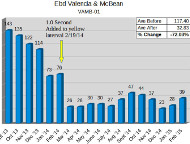3/25/2015
California: Longer Yellows Cut Violations In HalfLonger yellows for left turns cuts violations by more than half in Santa Clarita, California.

Cities frequently cite reductions in accidents at red light camera intersections as evidence that the devices are a valuable public safety tool. Behind the scenes, however, jurisdictions often implement engineering improvements that can have a big impact and are actually responsible for those numbers. Evidence for this can be found in Santa Clarita, California where the city council decided Tuesday to drop red light cameras in a 3 to 2 vote.
James Farley, a local resident, and Jay Beeber, Executive Director of Safer Streets LA, teamed up last year to present city officials with evidence of the need to increase the amount of yellow warning time given to motorists approaching an intersection to make a left-hand turn. The city agreed to conduct an experiment where the yellow time was increased at some red light camera intersections, but not others. The increased timing proved so effective that the photo ticketing program transformed overnight from a moneymaker issuing $5 million worth of tickets annually to a money loser issuing just $1.3 million worth. After paying Redflex Traffic Systems of Australia, the county and the state, Santa Clarita ended up $121,834 in the red.
The original city policy was to set yellow timing at a blanket 3.5 seconds for each left turn lane. Under this timing, Redflex was able to mail nine out of ten of its tickets to cars making left turns.
In 2014, the city boosted timing to as much as 4.5 seconds at the intersection of Valencia Boulevard and McBean Parkway. Three other locations were increased to 4.0 seconds, and the impact was immediate. Where a full second was added, violations dropped 71 percent. Where 0.5 seconds was added, the decrease was 58 percent. At the locations where the timing did not change, the number of violations held steady. The city was pleased by the outcome.
"Since the revised yellow-light timing was implemented, red-light running has dropped approximately 50 percent overall at the four intersections," city traffic engineer Andrew Yi explained in a memo to the council. "In most recent months, the trend has continued to hold with no noticeable increase in red-light running.... Citations issued in Fiscal Year 2013-14 are 45 percent lower than Fiscal Year 2012-13. This drop is directly attributed to fewer red-light violations due to the implementation of longer signal cycles and yellow-light times."
The city asked engineering firm Kimley Horn to study the locations so that it would have an engineering report on hand justifying all of the changes. Kimley Horn recommended even longer yellow phases of up to 4.9 seconds.
"Over the next several months, staff will implement the consultant's recommended policy citywide," Yi wrote. "It is anticipated this will result in further reductions of red-light running."
The city also installed extra traffic signal heads and modified lane striping to increase visibility.


